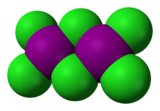
| |

| |

| |
| Names | |
|---|---|
| IUPAC name Iodine trichloride | |
| Other names Diiodine hexachloride | |
| Identifiers | |
| CAS Number | |
| 3D model (JSmol) | |
| ChemSpider | |
| ECHA InfoCard | 100.011.582 |
| PubChem CID | |
| UNII | |
| CompTox Dashboard (EPA) | |
InChI
| |
| SMILES | |
| Properties | |
| Chemical formula | I2Cl6 |
| Molar mass | 466.5281 g/mol |
| Appearance | yellow solid |
| Density | 3.11 g/cm |
| Melting point | 63 °C (145 °F; 336 K) |
| Magnetic susceptibility (χ) | −90.2×10 cm/mol |
| Except where otherwise noted, data are given for materials in their standard state (at 25 °C , 100 kPa).
| |
Iodine trichloride is an interhalogen compound of iodine and chlorine. It is bright yellow but upon time and exposure to light it turns red due to the presence of elemental iodine. In the solid state is present as a planar dimer I2Cl6, with two bridging Cl atoms.
It can be prepared by reacting iodine with an excess of liquid chlorine at −70 °C, or heating a mixture of liquid iodine and chlorine gas to 105 °C. In the molten state it is conductive, which may indicate dissociation:
- I2Cl6 ⇌ ICl
2 + ICl
4
It is an oxidizing agent, capable of causing fire on contact with organic materials. That oxidizing power also makes it a useful catalyst for organic chlorination reactions.
References
- K. H. Boswijk; E. H. Wiebenga (1954). "The crystal structure of I2Cl6 (ICl3)". Acta Crystallographica. 7 (5): 417–423. doi:10.1107/S0365110X54001260.
- ^ Greenwood, Norman N.; Earnshaw, Alan (1997). Chemistry of the Elements (2nd ed.). Butterworth-Heinemann. ISBN 978-0-08-037941-8.
- Sabatier, Paul (1922). Catalysis in Organic Chemistry (PDF). Translated by Reid, E. Emmet. New York, NY: Van Nostrand. p. 2.
| Iodine compounds | |
|---|---|
| Iodine(−I) | |
| Iodine(I) | |
| Iodine(II) | |
| Iodine(III) | |
| Iodine(IV) | |
| Iodine(V) | |
| Iodine(VII) | |
This inorganic compound–related article is a stub. You can help Misplaced Pages by expanding it. |